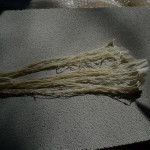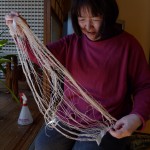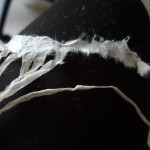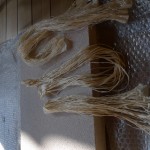For several years now, as part of my artmaking process, I have been spinning dictionary papers into threads. One of the traditional Japanese crafts that I wanted to learn while in Tokyo was shifu- turning paper into thread. This is definitely an art that has almost disappeared in Japan and presently, shifu is practiced by few. Historically, fibres such as hemp, flax and ramie were used for weaving everyday clothes; there were no sheep for making wool, cotton was not a indigenous plant and silk was reserved for the upper class and nobility. In areas were there were not enough fibres for weaving, paper was used to make clothing. Paper cloth when treated with konyaku ( the starch-like substance of a root vegetable ) becomes quite waterproof and strong. Paper as a fabric breathes while keeping rain, cold and wind out. Kamiko – cloth made from paper and treated with konyaku is still made for ceremonial kimonos for monks. To make one kimono, it takes approximately 50 sheets of paper (636mm x 939mm) or 13 metres of cloth. A daunting task, given the amount of time it took me to just make the thread.
France Goneau, the Québec artist-in-resident in Tokyo several years ago, gave me Emiko Nakano’s address (see an earlier post: A Special Afternoon with Emiko, February 12, 2014). Emiko, a textile artist gracefully agreed to show me how to do shifu and welcomed me into her home over a period of four days.
Here are some images of an obi (the belt used for a kimono) that Emiko owns made entirely from paper thread. Often only the weft threads are paper, the warp being the first threads to go on the loom. The tell-tale signs of a paper thread are the tiny irregular bumps on the threads – these are the omu, caused by the technique called “Umu” the verb for turning in Japanese. This is evidence of the turning of the paper strip, where the bottom of one strip is turned over onto the top of the next strip. (see photos below)

 Special washi paper was ordered and delivered to Emiko’s home for my project. The first afternoon, Emiko showed me how to cut one 12.6 gram sheet of washi into long strips. For learning purposes, Emiko had me cut the sheet of paper into four different groups of widths: 10mm., 6mm., 3mm. and 2mm. To slowly humidify, it was left overnight in a damp towel, under plastic and weighted.
Special washi paper was ordered and delivered to Emiko’s home for my project. The first afternoon, Emiko showed me how to cut one 12.6 gram sheet of washi into long strips. For learning purposes, Emiko had me cut the sheet of paper into four different groups of widths: 10mm., 6mm., 3mm. and 2mm. To slowly humidify, it was left overnight in a damp towel, under plastic and weighted.
- Good measuring tools are essential for the precision needed in shifu
- The paper is folded length-wise, leaving the edges together
- Measuring and cutting
- Gently roll together once cut
- Transfer onto a damp towel to leave overnight
The following day, I returned to proceed with the next step. The sheet of cut paper was removed from the towel and weights and gently roughened and crushed over a concrete surface. For coarser threads, this step can be done simply by rolling the paper in your hands.
- Gently rolling on a rough surface
- Rolled and roughened strips
- Checking for entangled strips
- Start by detaching one strip on one end of the paper
- Preparing to make the omu
- This is the omu – twisting over the ends over with your thumb
- Drop the strip into a basket as you go..
- Once one end of the strips are all connected you begin the other end to make one long strip
- Wind the entire strip into a butterfly. Tie bundle with end and leave beginning end free
Now the actual spinning can begin. I used drop spindles of two different weights, one for the two heaver threads and a lighter one for the 3 and 2mm. widths of thread. I tied the loose end of a bundle onto the spindle and spun with a right spin or a-Z spin for weft threads. It is possible to then twist to make a two-ply yarn of two Z threads. An S or left spin is for warp threads. To fix the twist, wind the thread onto a reel and drop into boiling water for 5 minutes.
What I will do with these threads…….only time will tell!
- Paper ready to make single strip
- Spindles and spun paper thread
- Spun thread
- Four sizes of spun thread

















